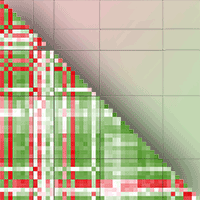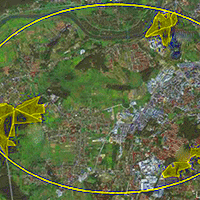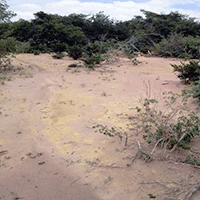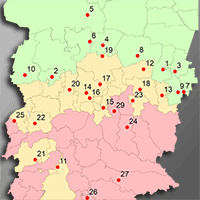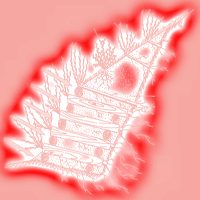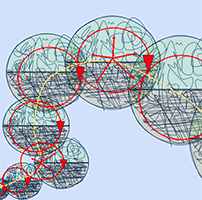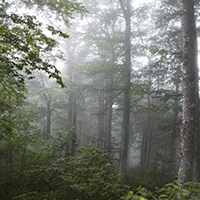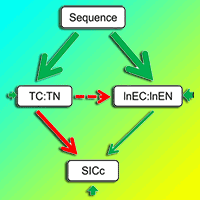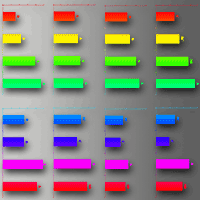
Soil of the parent plant and AMF mix improve Cerrado’s seedlings growth in forest nurseries
Gustavo Mattos Abreu (1) , Haroldo Nogueira de Paiva (1), Maria Catarina Megumi Kasuya (2), Samuel Dutra de Paula (1), Bruna Duque Guirardi (1), Guilherme de Moura Araújo (3)
iForest - Biogeosciences and Forestry, Volume 15, Issue 3, Pages 197-205 (2022)
doi: https://doi.org/10.3832/ifor3833-015
Published: May 28, 2022 - Copyright © 2022 SISEF
Research Articles
Abstract
The soil microbiota plays an extremely important role in the growth and survival of plants. The presence of some microorganisms can positively and significantly impact the growth of tree species, which can improve the performance of seedlings after planting for commercial purposes and/or for ecosystem restoration. The present study aimed to evaluate the initial growth of seedlings of Hancornia speciosa and Brosimum gaudichaudii associated with microorganisms from the soil of the parent tree and/or inoculated with arbuscular mycorrhizal fungi (AMF). Four substrates were tested: T1 (control) = Autoclaved dystrophic Red-Yellow Latosol (Aut-dRYL) + autoclaved commercial substrate (Aut-CS); T2 = Aut-dRYL + Aut-CS + inoculum of AMF (Mix); T3 = Aut-dRYL + Aut-CS + soil of the parent plant (SPP); and T4 = Aut-dRYL + Aut-CS + SPP + Mix. The AMF inoculum comprised a mix of the species Gigaspora decipiens, Rhizophagus clarus, and Scutellospora heterogama. Seedling growth was determined 270-350 days after transplanting by measuring the following parameters: mycorrhizal colonization rate (MC), abundance of spores (AS), height (H), stem diameter (D), H/D ratio, volume of roots (VR), dry matter of shoot (SDM), roots (RDM), total (TDM), shoot / root dry matter ratio (SDM/RDM), height / shoot dry matter ratio (H/SDM), and Dickson quality index (DQI). The results showed that the addition of SPP improved the growth and DQI of the seedlings, while the AMF mix minimally changed both growth and DQI. The use of symbiotic microorganisms in the nursery in Brazil is scarse due to the difficulty of acquiring these microorganisms and the lack of commercialization of specific isolates for species native to the Cerrado biome. The present study evaluated the use of soil from naturally occurring areas as a source of inoculum. The higher growth and biomass production of inoculated plants support the use of SPP as a form of inoculum and/or inoculation with native AMF to produce seedlings of H. speciosa and B. gaudichaudii.
Keywords
Forest Nurseries, Biological Inoculants, Dickson Quality Index
Authors’ Info
Authors’ address
Haroldo Nogueira de Paiva 0000-0002-8891-5373
Samuel Dutra de Paula 0000-0002-3934-8317
Bruna Duque Guirardi 0000-0002-6003-2755
Departamento de Engenharia Florestal, Universidade Federal de Viçosa, Viçosa, Minas Gerais (Brazil)
Departamento de Microbiologia/BIOAGRO, Universidade Federal de Viçosa, Viçosa, Minas Gerais (Brazil)
Departamento de Engenharia Agrícola, Universidade Federal de Viçosa, Viçosa, Minas Gerais (Brazil)
Corresponding author
Paper Info
Citation
Abreu GM, Paiva HN, Megumi Kasuya MC, Paula SD, Guirardi BD, Araújo GM (2022). Soil of the parent plant and AMF mix improve Cerrado’s seedlings growth in forest nurseries. iForest 15: 197-205. - doi: 10.3832/ifor3833-015
Academic Editor
Maurizio Ventura
Paper history
Received: Mar 30, 2021
Accepted: Mar 01, 2022
First online: May 28, 2022
Publication Date: Jun 30, 2022
Publication Time: 2.93 months
Copyright Information
© SISEF - The Italian Society of Silviculture and Forest Ecology 2022
Open Access
This article is distributed under the terms of the Creative Commons Attribution-Non Commercial 4.0 International (https://creativecommons.org/licenses/by-nc/4.0/), which permits unrestricted use, distribution, and reproduction in any medium, provided you give appropriate credit to the original author(s) and the source, provide a link to the Creative Commons license, and indicate if changes were made.
Web Metrics
Breakdown by View Type
Article Usage
Total Article Views: 7677
(from publication date up to now)
Breakdown by View Type
HTML Page Views: 3573
Abstract Page Views: 2326
PDF Downloads: 1361
Citation/Reference Downloads: 0
XML Downloads: 417
Web Metrics
Days since publication: 1304
Overall contacts: 7677
Avg. contacts per week: 41.21
Citation Metrics
Article Citations
Article citations are based on data periodically collected from the Clarivate Web of Science web site
(last update: Mar 2025)
Total number of cites (since 2022): 2
Average cites per year: 0.50
Publication Metrics
by Dimensions ©
Articles citing this article
List of the papers citing this article based on CrossRef Cited-by.
References
Crescimento inicial e absorção de fósforo e nitrogênio de Enterolobium contortisiliquum inoculada com fungos micorrízicos arbusculares [Initial growth and phosphorus and nitrogen uptake of Enterolobium contortisiliquum inoculated with arbuscular mycorrhizal fungi]. Revista de Ciências Agrárias 41: 156-164. [in Portuguese]
CrossRef | Gscholar
Working mycorrhizas in forestry and agriculture. Australian Center for Agricultural Research, Canberra, Australia, pp. 374.
Gscholar
Influência de fungos micorrízicos arbusculares sobre o crescimento de três leguminosas arbóreas [Influence of arbuscular mycorrhizal fungi on the growth of three leguminous trees]. Revista Acadêmica: Ciências Agrárias e Ambientais 1: 27-32. [in Portuguese]
CrossRef | Gscholar
Qualidade de mudas de nó-de-cachorro (Heteropteris aphrodisiaca O. Mach.) em diferentes substratos [Quality of Heteropteris aphrodisiaca O. Mach. seedlings in different substrates]. Revista Brasileira de Plantas Medicinais 10: 82-90. [in Portuguese]
CrossRef | Gscholar
Micorrização e indução de quitinases e β-1.3-glucanases e resistência à fusariose em porta-enxerto de videira [Mycorrhizal inoculation and induction of chitinases and β-1.3-glucanases and fusarium resistance in grapevine rootstock]. Pesquisa Agropecuária Brasileira 45: 376-383. [in Portuguese]
CrossRef | Gscholar
Relação de fungos micorrízicos arbusculares e rizobactérias no crescimento de mudas de oliveira (Olea europaea) [Relationship of arbuscular mycorrhizal fungi and rhizobacteria on the growth of olive tree seedlings (Olea europaea)]. Ciência Florestal 29: 169-180. [in Portuguese]
CrossRef | Gscholar
Combinations of blue and red LEDs increase the morphophysiological performance and furanocoumarin production of Brosimum gaudichaudii Trécul in vitro. Frontiers in Plant Science 12: 680545.
CrossRef | Gscholar
Sistemas agroflorestais e o Cerrado [Agroforestry systems and Cerrado]. In: “Savana: Desafios e Estratégias para o Equilíbrio entre Sociedade, Agronegócio e Recursos Naturais” (Faleiro F, Farias Neto AL eds). Embrapa Cerrados, Planaltina, Brazil, pp. 965-985. [in Portuguese]
Gscholar
Efeito de Glomus etunicatum e fósforo no crescimento inicial de espécies arbóreas em semeadura direta [Effects of Glomus etunicatum and phosphorus on initial growth of woody species at direct seeding]. Pesquisa Agropecuária Brasileira 38: 257-266. [in Portuguese]
CrossRef | Gscholar
Crescimento de mudas de Dipteryx alata sob adubação fosfatada e calagem [Seedling growth of Dipteryx alata under phosphorus fertilization and liming]. Ambiência 14: 267-281. [in Portuguese]
Gscholar
Viveiros florestais: propagação sexuada [Forest nurseries: sexed propagation]. Editora UFV, Viçosa, Brazil, pp. 116. [in Portuguese]
Gscholar
Microbiologia e bioquímica do solo [Soil microbiology and biochemistry]. UFLA, Lavras, Brazil, pp. 729. [in Portuguese]
Gscholar
Morfología y establecimiento de los plantones [Seedling morphology and establishment]. In: “Calidad de Planta Forestal para la Restauración en Ambientes Mediterráneos Degradados: Estado Actual de Conocimientos” (Cortina J, Peñuelas JL, Puértolas J, Savé J, Vilagrosa A eds). Ministerio de Medio Ambiente, Madrid, Spain, pp. 67-88. [in Spanish]
Gscholar
Fertilidade do solo [Soil fertility]. Sociedade Brasileira de Ciência do Solo, Viçosa, Brazil, pp. 1017. [in Portuguese]
Gscholar
Effect of phosphorus fertilization on arbuscular mycorrhizal colonization of Zeyheria tuberculosa a native species in Brazil’s forest. Middle-East Journal of Scientific Research 6: 604-611.
Gscholar
Germinação in vitro de mangabeira (Hancornia speciosa Gomez) em diferentes meios de cultura [In vitro germination of mangabeira (Hancornia speciosa Gomez) in differents cultura media]. Revista Brasileira de Fruticultura 23: 413-416. [in Portuguese]
CrossRef | Gscholar
Fitofisionomias do bioma Cerrado [Phytophysiognomies of Cerrado biome]. In: “Cerrado: Ecologia e Flora” (Sano SM, Almeida SP eds). Embrapa Cerrados, Planaltina, Brazil, pp. 89-168. [in Portuguese]
Gscholar
Micorriza arbuscular - papel, funcionamento e aplicação da simbiose [Arbuscular mycorrhiza - role, function and application of symbiosis]. In: “Processos Biológicos do Sistema Solo-Planta: Ferramentas para uma Agricultura Sustentável” [Biological Processes of the Soil-Plant System: Tools for Sustainable Agriculture] (Aquino AM, Assis RL eds). Embrapa Informação Tecnológica, Brasília, Brazil, pp. 101-149. [in Portuguese]
Gscholar
Desempenho de mudas de gravioleira inoculadas com fungos micorrízicos arbusculares em solo não-esterilizado, com diferentes doses de fósforo [Performance of soursop seedlings inoculated with arbuscular mycorrhizal fungi in non-sterilized soil, with different phosphorus doses]. Acta Scientiarum - Agronomy 33: 81-88. [in Portuguese]
CrossRef | Gscholar
Análises químicas para a avaliação da qualidade do solo [Chemical analyzes for soil quality assessment]. In: “Manual de Análises Químicas de Solos, Plantas e Fertilizantes” [Manual of Chemical Analysis of Soil, Plant and Fertilizer] (Silva FC ed). EMBRAPA, Brasília, Brazil, pp. 75-169. [in Portuguese]
Gscholar
Propagação vegetativa de Brosimum gaudichaudii Tréc. (mama-cadela) por estacas de raízes [Vegetative propagation of Brosimum gaudichaudii Tréc. (mama-cadela) by root cuttings]. Revista Brasileira de Plantas Medicinais 13: 151-156. [in Portuguese]
CrossRef | Gscholar
Fungos micorrízicos arbusculares no controle de Meloidogyne incognita em mudas de tomateiro [Arbuscular mycorrhizal fungi in the control of Meloidogyne incognita in tomato seedlings]. Caatinga 23: 15-20. [in Portuguese]
Gscholar
Moist sand conditioning to minimize loss of viability in cocoa (Theobroma cacao Linn.) seed. Natural Product Radiance 4: 487-491.
Gscholar

